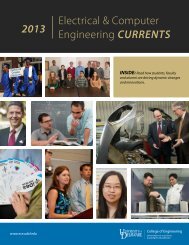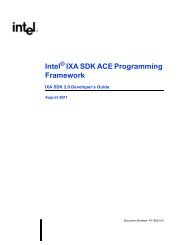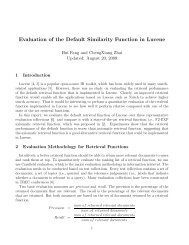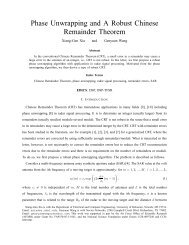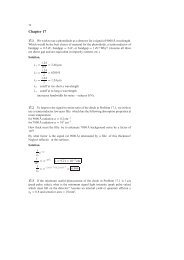30 <strong>3D</strong> joint reconstruction from full <strong>3D</strong> measurement Approach 2 Approach 1 32 <strong>3D</strong> joint reconstruction from 2D measurement Approach 3 Approach 1 28 30 28 26 PSNR (dB B) 24 PSNR (dB B) 26 24 22 22 20 20 18 0 20 40 60 80 100 120 140 Number of slice 18 0 20 40 60 80 100 120 140 Number of slice (a) (b) Figure 8. PSNR for 128 × 128 × 128 <strong>3D</strong> image, sampling rate 30%. (a) <strong>3D</strong> joint reconstruction from full <strong>3D</strong> measurement, mean(PSNR)=26.9 dB (b) <strong>3D</strong> joint reconstruction from 2D measurement, mean(PSNR)=26.8 dB Figure 9. Reconstructed image from SBHE based method 3, sampling rate=30%, image size=128×128×128, reconstruction algorithm: l 1 regularized least square algorithm. 4. THEORETICAL ANALYSIS The performance of the proposed imaging system depends on several factors. The resultant imaging quality can be determined by considering the signal-to-noise ratio (SNR) as the performance measurement of the acquisition system. There are a variety of noise sources in the signal chain. In fluorescence microscopy, where photobleaching limits the total exposure and hence the number of photons that can be detected, photon counting noise (shot noise) would be the dominant component. As it was shown in Ref[18], the number of photons hitting the detector over a time period follows a Poisson distribution with mean equals to its variance. Thus the noise N = √ S + B, where S and B are, respectively, the number of detected signal and background photons. Then the signal-to-noise ratio SNR = S/N = S/ √ S + B. 18 In CCM, the detected signal contains contributions from all micromirrors at the ′ on ′ position. Thus, if there are K such ′ on ′ positions, and suppose the signal and noise level at each position are the same, then we have SNR = KS/ √ KS + KB = √ KS/ √ S + B. Therefore, compared to conventional imaging system using CCD detectors, CCM offers greatly improved SNR. In Table 1, we provide a complexity comparison of conventional confocal microscope, compressive confocal microscope (CCM) and programmable array microscope (PAM) with respect to their acquisition time, number of measurement and dynamic range required by the sensor. As for CCM, we consider the configuration required for Approach 1 and Approach 3 that were introduced in Section 3. Assuming that the time (t) to get one snapshot of the image is the same for the three systems. In conventional CM, only one point is measured at a time, therefore
Table 1. Complexity comparison of the three confocal imaging systems. Conventional CM CCM PAM Acquisition time N 3 t M × t + t r ( N 2 n x n y ) × Nt Number of measurement N 3 M N 3 Dynamic Range D D × K D to form the whole N × N × N thick image, it requires an acquisition time of N 3 t. While in PAM with a grid pattern, if n x n y multiple points are measured at one time, the acquisition time will be reduced to ( N 2 n x n y ) × Nt. In CCM, the image formation time that includes the image acquisition time for obtaining the M measurements, M × t, and the time t r for computing the non-linear optimization program to reconstruct the original image is Mt + t r . Since in CCM, a single detector is used to detect contributions from K illuminated pixels, the dynamic range required is increased from D to KD. 5. CONCLUSIONS In the proposed CCM, a DMD is used to efficiently scan the 2D or <strong>3D</strong> specimen. The measured data in the CCM system emerge from random sets of pinhole illuminated pixels in the specimen that are linearly combined (projected) and measured by a single photon detector. Compared to conventional CM or PAM, the proposed CCM has the potential advantage of simplifying the hardware and optical complexity of confocal imaging systems by off-loading the processing from the data acquisition stage into that of image reconstruction which is software driven leading thus to a lower-cost imaging system. Furthermore, it offers the unique optical sectioning property of confocal imaging at reduced sampling rate. To further improve the system, we designed a <strong>3D</strong> joint reconstruction method to fully exploit the correlation between image slices within the <strong>3D</strong> image volume. Compared to 2D sliceby-slice method, this method offers significant increased PSNR in reconstructed image, while the computational complexity remains practically the same. REFERENCES [1] Wilson, T., [<strong>Confocal</strong> <strong>Microscopy</strong>], Academic Press (1990). [2] Petran, M., Hadravsky, M., Egger, M. D., and Galambos, R. J., “Tandem-scanning reflected-light microscope,” J. Microsc 58, 661–664 (1968). [3] Liang, M., Stehr, R. L., and Krause, A. W., “<strong>Confocal</strong> pattern period in multiple-aperture confocal imaging systems with coherent illumination,” Optics Letters 22 (June 1 1997). [4] Verveer, P. J., Hanley, Q. S., Verbeek, P. W., van Vliet, L. J., and Jovin, T. M., “Theory of confocal fluorescence imaging in the programmable array microscope (PAM),” J. Opt. Soc. Am. 3, 192–198 (1998). [5] Wilson, T., Juskaitis, R., Neil, M. A. A., and Kozubek, M., “<strong>Confocal</strong> microscopy by aperture correlation,” Optics Letters 21 (December 1996). [6] Candés, E., Romberg, J., and Tao, T., “Robust uncertainty principles: Exact signal reconstruction from highly incomplete frequency information,” IEEE Trans. Information Theory 52, 489–509 (2006). [7] Candés, E. and Tao, T., “Near-optimal signal recovery from random projections and universal encoding strategies?,” IEEE Trans. Information Theory 52, 5406–5245 (2006). [8] Ye, P., Paredes, J. L., Arce, G. R., Wu, Y., Chen, C., and Prather, D. W., “<strong>Compressive</strong> confocal microscopy,” Proc. ICASSP (April. 2009). [9] Kim, S.-J., Koh, K., Lustig, M., Boyd, S., and Gorinevsky, D., “An interior-point method for large-scale l1 regularized least squares,” IEEE Journal of selected topics in Signal Processing 1 (Dec. 2007). [10] Gan, L., Do, T. T., and Tran, T. D., “Fast compressive imaging using scrambled block hadamard ensemble,” (2008). Preprint. [11] Do, T. T., Tran, T. D., and Gan, L., “Fast compressive sampling with structually random matrices,” Proc. ICASSP (Mar. 2007). [12] Candés, E. and Romberg, J., “L1magic: Recovery of sparse signals via convex programming.” Caltech (Oct. 2005).



